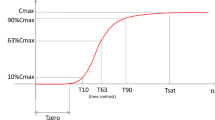Abstract
Helium is nontoxic at standard conditions, plays no biological role, and is found in trace amounts in human blood. Helium can be dangerous if inhaled to excess, since it is a simple tissue hypoxia and so displaces the oxygen needed for normal respiration. This report presents a fatal case of a middle-aged male victim who died from self-administered helium exposure. For the first time, the quantification of the helium levels in gastric and lung air and in blood samples was achieved using gas chromatography—mass spectrometry after airtight sampling. The results of the toxicological investigation showed that death was caused directly by helium exposure. However, based on the pathomorphological changes detected during the forensic autopsy, we suppose that the fatal outcome was the result of the lack of oxygen after inhalation.






Similar content being viewed by others
References
Billoch Lima J.G., Sannabria-Bellasai D., Rivera-Diez I. (2011). New suicide modalities: The use of helium as an oxygen displacement agent. 31er Foro Annual de Investigacion y Educacion, 3-6 May 2011, Universidad de Puerto Rico
Ogden RD, Wooten RH (2002) Asphyxial suicide with helium and a plastic bag. Am J Forensic Med Pathol 23:234–237
Gilson T, Parks BO, Porterfield CM (2003) Suicide with inert gases. Am J Forensic Med Pathol 24(3):306–308
Gallagher KE, Smith DM, Mellen PF (2003) Suicidal asphyxiation by using pure helium gas: case report, review, and discussion of the influence of the Internet. Am J Forensic Med Pathol 24(4):361–363
Barnung SK, Feddersen C (2004) Suicide by inhaling helium inside a plastic bag. Ugeskr Laeger 166:3506–3507
Grassberger M, Krauskopf A (2007) Suicidal asphyxiation with helium: report of three cases suizid mit helium gas: bericht über drei fälle. Wien Klin Wochenschr 119(9–10):323–325
Odgen RD (2010) Observation of two suicides by helium inhalation in a prefilled environment. Am J Forensic Med Pathol 31(2):156–161
Odgen RD, Hamilton WK, Whitcher C (2010) Assisted suicide by oxygen deprivation with helium at a Swiss right-to-die organisation. J Med Ethics 36:174–179
Austin A, Winskog C, Van Den Heuvel C, Byard RW (2011) Recent trends in suicides utilizing helium. J Forensic Sci 56(3):649–651
Odgen RD, Hassan S (2011) Suicide by oxygen deprivation with helium: a preliminary study of British Columbia coroner investigations. Death Stud 35(4):338–364
Frost J (2013) Death by self-inflicted asphyxia with helium—first case reports from Norway and review of the literature. Scandinavian J Forensic Sci 19(2):52–54
Howard MO, Hall MT, Edwards JD, Vaughn MG, Perron BE, Winecker RE (2011) Suicide by asphyxiation due to helium inhalation. Am J Forensic Med Pathol 32(1):61–70
Yoshitome K, Ishikawa T, Inagaki S, Yamamoto Y, Miyaishi S, Ishizu H (2002) A case of suffocation by an advertising balloon filled with pure helium gas. Acta Med Okayama 56:53–55
Schön CA, Ketterer T (2007) Asphyxial suicide by inhalation of helium inside a plastic bag. Am J Forensic Med Pathol 28(4):364–367
Musshoff F, Hagemeier L, Kirschbaum K, Madea B (2012) Two cases of suicide by asphyxiation due to helium and argon. Forensic Sci Int 223:e27–e30
Wiergowski M, Kaliszan M, Suminska-Ziemann B, Gos T, Jankowski Z (2014) Helium detection in the lungs in case of suicide by helium inhalation—case report and literature review. Rom J Leg Med 22:153–156
Auwaerter V, Grosse Perdekamp M, Kempf J, Schmidt U, Weinmann W, Pollak S (2007) Toxicological analysis after asphyxial suicide with helium and a plastic bag. Forensic Sci Int 139–141
Varlet V, Bouvet A, Augsburger M (2012) Argon: uses, toxicity and analytical strategy in forensic toxicology. Ann Toxicol Anal 24(4):185–192
Schaff JE, Karas RP, Marinetti L (2012) A gas chromatography-thermal conductivity detection method for helium detection in postmortem blood and tissue specimens. J Anal Toxicol 36:112–115
Tanaka N, Kinoshita H, Jamal M, Kumihashi M, Tobiume T, Tsutsui K, Ameno K (2013) Usefulness of intratracheal gas analysis in an autopsy case of helium inhalation. Rom J Leg Med 21:237–238
Author information
Authors and Affiliations
Corresponding author
Rights and permissions
About this article
Cite this article
Malbranque, S., Mauillon, D., Turcant, A. et al. Quantification of fatal helium exposure following self-administration. Int J Legal Med 130, 1535–1539 (2016). https://doi.org/10.1007/s00414-016-1364-x
Received:
Accepted:
Published:
Issue Date:
DOI: https://doi.org/10.1007/s00414-016-1364-x




